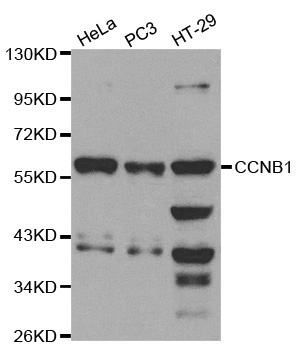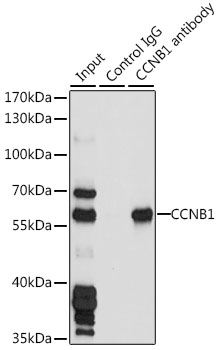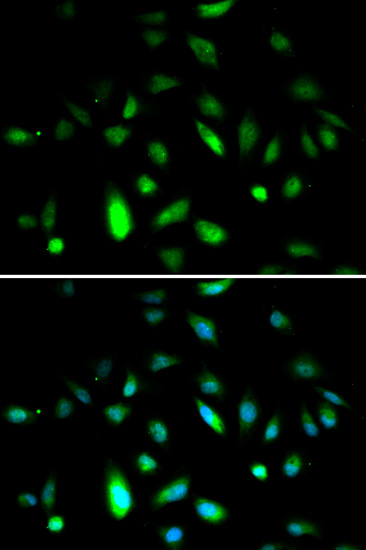Product Name :
Cyclin B1 polyclonal antibody Background :
Cyclins are a family of proteins that activate specific cyclin-dependent kinases required for progression through the cell cycle. The entry of all eukaryotic cells into mitosis is regulated by activation of cdc2/cdk1 at the G2/M transition. This activation is a multi-step process that begins with the binding of the regulatory subunit, cyclin B1, to cdc2/cdk1 to form the mitosis-promoting factor (MPF). MPF remains in the inactive state until phosphorylation of cdc2/cdk1 at Thr161 by cdk activating kinase (CAK) and dephosphorylation of cdc2/cdk1 at Thr14/Tyr15 by cdc25C. Four cyclin B1 phosphorylation sites (Ser126, 128, 133, and 147) are located in the cytoplasmic retention signal (CRS) domain and are thought to regulate the translocation of cyclin B1 to the nucleus at the G2/M checkpoint, promoting nuclear accumulation and initiation of mitosis. While MPF itself can phosphorylate Ser126 and Ser128, polo-like kinase 1 (PLK1) phosphorylates cyclin B1 preferentially at Ser133 and possibly at Ser147. At the end of mitosis, cyclin B1 is targeted for degradation by the anaphase-promoting complex (APC), allowing for cell cycle progression. Research studies have shown that cyclin B1 is overexpressed in breast, prostate, and non-small cell lung cancers. Product :
Rabbit IgG, 1mg/ml in PBS with 0.02% sodium azide, 50% glycerol, pH7.2 Storage&Stability :
Store at 4°C short term. Aliquot and store at -20°C long term. Avoid freeze-thaw cycles. Specificity :
CCNB1 polyclonal antibody detects endogenous levels of CCNB1 protein. Immunogen :
A synthetic peptide of human CCNB1. Conjugate :
Unconjugated Modification :
Unmodification
Cyclin B1 polyclonal antibody Background :
Cyclins are a family of proteins that activate specific cyclin-dependent kinases required for progression through the cell cycle. The entry of all eukaryotic cells into mitosis is regulated by activation of cdc2/cdk1 at the G2/M transition. This activation is a multi-step process that begins with the binding of the regulatory subunit, cyclin B1, to cdc2/cdk1 to form the mitosis-promoting factor (MPF). MPF remains in the inactive state until phosphorylation of cdc2/cdk1 at Thr161 by cdk activating kinase (CAK) and dephosphorylation of cdc2/cdk1 at Thr14/Tyr15 by cdc25C. Four cyclin B1 phosphorylation sites (Ser126, 128, 133, and 147) are located in the cytoplasmic retention signal (CRS) domain and are thought to regulate the translocation of cyclin B1 to the nucleus at the G2/M checkpoint, promoting nuclear accumulation and initiation of mitosis. While MPF itself can phosphorylate Ser126 and Ser128, polo-like kinase 1 (PLK1) phosphorylates cyclin B1 preferentially at Ser133 and possibly at Ser147. At the end of mitosis, cyclin B1 is targeted for degradation by the anaphase-promoting complex (APC), allowing for cell cycle progression. Research studies have shown that cyclin B1 is overexpressed in breast, prostate, and non-small cell lung cancers. Product :
Rabbit IgG, 1mg/ml in PBS with 0.02% sodium azide, 50% glycerol, pH7.2 Storage&Stability :
Store at 4°C short term. Aliquot and store at -20°C long term. Avoid freeze-thaw cycles. Specificity :
CCNB1 polyclonal antibody detects endogenous levels of CCNB1 protein. Immunogen :
A synthetic peptide of human CCNB1. Conjugate :
Unconjugated Modification :
Unmodification
-
 Western blot analysis of extracts from normal (control) and Cyclin B1 knockout (KO) HeLa cells, using Cyclin B1 antibody at 1:1000 dilution.
Western blot analysis of extracts from normal (control) and Cyclin B1 knockout (KO) HeLa cells, using Cyclin B1 antibody at 1:1000 dilution. -
 Western blot analysis of extracts of Mouse liver, using Cyclin B1 antibody at 1:1000 dilution.
Western blot analysis of extracts of Mouse liver, using Cyclin B1 antibody at 1:1000 dilution. -
 Western blot analysis of extracts of Mouse liver, using Cyclin B1 antibody at 1:1000 dilution.
Western blot analysis of extracts of Mouse liver, using Cyclin B1 antibody at 1:1000 dilution. -
 Western blot analysis of extracts of Mouse liver, using Cyclin B1 antibody at 1:1000 dilution.
Western blot analysis of extracts of Mouse liver, using Cyclin B1 antibody at 1:1000 dilution.
Suppression of motor protein KIF3C expression inhibits tumor growth and metastasis in breast cancer by inhibiting TGF-β signaling
PMCID: Pubmed No.:26272184
DACT2 is frequently methylated in human gastric cancer and methylation of DACT2 activated Wnt signaling
PMCID: Pubmed No.:25520862
LRD-22, a novel dual dithiocarbamatic acid ester, inhibits Aurora-A kinase and induces apoptosis and cell cycle arrest in HepG2 cells
PMCID: Pubmed No.:25645017
TPX2 Level Correlates with Hepatocellular Carcinoma Cell Proliferation, Apoptosis, and EMT
PMCID: Pubmed No.:26025609
RASSF10 suppresses colorectal cancer growth by activating P53 signaling and sensitizes colorectal cancer cell to docetaxel
PMCID: Pubmed No.:25638156
Silencing NKD2 by promoter region hypermethylation promotes gastric cancer invasion and metastasis by up-regulating SOX18 in human gastric cancer
PMCID: Pubmed No.:26396173
TPX2 level correlates with cholangiocarcinoma cell proliferation, apoptosis, and EMT
PMCID: Pubmed No.:30257343
-Hederin Arrests Cell Cycle at G2/M Checkpoint and Promotes Mitochondrial Apoptosis by Blocking Nuclear Factor-B Signaling in Colon Cancer Cells
PMCID: Pubmed No.:30363706
Bioworld Biotech only provide peptides for our antibodies and do not provide additional peptide customization services.
Price/Size :
USD 368/1mg/vial
Tips:
For phospho antibody, we provide phospho peptide(0.5mg) and non-phospho peptide(0.5mg).Describe :
Blocking peptides are peptides that bind specifically to the target antibody and block antibody binding. These peptide usually contains the epitope recognized by the antibody. Antibodies bound to the blocking peptide no longer bind to the epitope on the target protein. This mechanism is useful when non-specific binding is an issue, for example, in Western blotting (WB) and Immunohistochemistry (IHC). By comparing the staining from the blocked antibody versus the antibody alone, one can see which staining is specific; Specific binding will be absent from the western blot or IHC performed with the neutralized antibody.Formula:
Synthetic peptide was lyophilized with 100% acetonitrile and is supplied as a powder. Reconstitute with 0.1 ml DI water for a final concentration of 10 mg/ml.The purity is >90%,tested by HPLC and MS.
Storage:
The freeze-dried powder is more stable. For short time at 2-8°C. For long term storage store at -20°C.
Note :
This product is for research use only (RUO only). Not for use in diagnostic or therapeutic procedures.
 Cyclin B1 polyclonal antibody
Cyclin B1 polyclonal antibody  Datasheet
Datasheet COA
COA MSDS
MSDS SHIP
SHIP